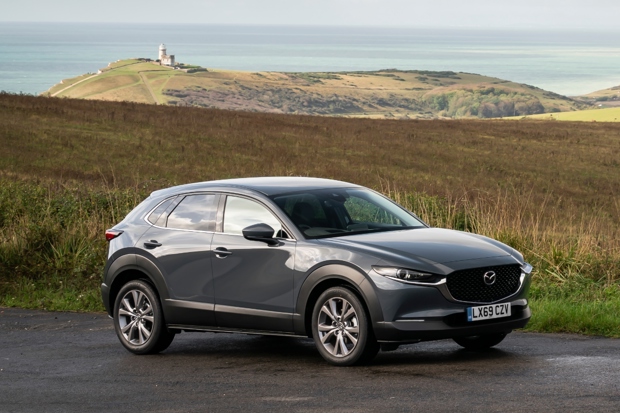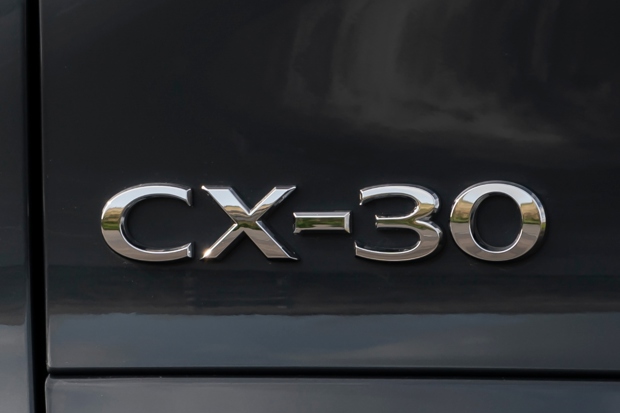Our Mazda CX-30 has arrived
Georgia begins six months with Mazda's newest crossover - the CX-30. Exciting.

Date: 14 February 2020 | Current mileage: 1056 | Claimed economy: 47.9mpg | Actual economy: 42.4
Our Mazda CX-30 has just joined the HJ fleet and we're getting to grips with it, replacing a Vauxhall Crossland X which Georgia's driven for the last few months. Our CX-30 Sport Lux 2WD features the 180PS 2.0-litre Skyactiv-X engine (which sits across the range).
Essentially, it's a big Mazda 3 - which we already rate very highly. Especially the manual transmission. In fact, we’ve given it a five-star review and it currently holds the HJ Family Car of the Year award. But if it lacks anywhere it’s in practicality terms.
Visually, it looks a lot like the Mazda CX-3, but arguably looks like it's been given slightly odd proportions for a crossover. That's because Mazda has given the CX-30 a shorter wheelbase than the 3, but it feels every bit as tall and spacious as any other family crossover.
So it looks good, it's reasonably practical and it's refined - even on the motorway. But, and it's a big one, the weakness of the CX-30 is the engine line-up. Partly because of Mazda’s refusal to follow the downsizing/turbocharging trend - instead, giving our crossover a lumbering 2.0-litre petrol engine that can feel underpowered at times. We'll discuss the Skyactiv-X engine in detail in a later update.

The Sport Lux isn't the top of the range trim, but it's the next best - with a host of features that include 18-inch alloy wheels, heated front seats, stop-start and keyless entry. As standard on this spec, we also get adaptive LED headlights, a Piano Black front grille, privacy glass on the rear windows, front and rear parking sensors, electric tailgate and a reversing camera.
Inside the car, there's Bluetooth, Mazda's Navigation system, Apple CarPlay and Android Auto. Most impressively, though, there's a windscreen-projected Active Driving Display that shows your speed and the speed limit. It also offers voiced speed warning and turn-by-turn navigation.
On the steering wheel, there's an adjustable speed limiter and cruise control. Other safety aspects worth mentioning include an electronic handbrake, Blind Spot Monitoring, Driver Attention Alert, e-Call with GPS, Emergency Stop Signalling, Smart Brake Support, Traffic Sign Recognition and Tyre Pressure Monitoring System (TPMS).
All that gear comes to £25,540 without extras. In that vain, the SE-L (£22,940) might be the most affordable version on sale but no CX-30 is cheap. But there’s no shortage of small, sporty crossovers on the market. Only time will tell how the CX-30 stacks up against some of its rivals like the Volkswagen T-Roc and Kia XCeed.
Sluggish or sporty: 2.0-litre petrol engine evaluations
Georgia runs through the pros and cons of Mazda's only engine option in the range, the 2.0-litre Skyactiv.

Date: 28 February 2020 | Current mileage: 1485 | Claimed economy: 47.9mpg | Actual economy: 42.5
Engines, not the most fun thing to talk about - we're big enough to admit that. But sometimes, it's necessary. And this is one of those times.
The engine range of the Mazda CX-30 is about as uninspired as dressing up as a witch for halloween. It's a real weakness in an otherwise great compact crossover. Firstly because Maza has opted for a 2.0-litre petrol engine across its line-up rather than turbocharging its engines - as is typical now. There are a range of the 2.0-litre variants paired with manual or auto gearboxes and 2WD or 4WD. But there's no diesel.
Instead, it's put a compression combustion petrol engine that in theory combines the positive torque and efficiency characteristics of a diesel with the refinement of a petrol - the so-called Skyactiv-X, a world first in a production car.
It’s an impressive technical achievement, and one that aims to give the best of both worlds: the torque at low revs of a diesel with the punchiness of a petrol. Effectively, it used a supercharger to help create a very lean air-fuel mix that can be combusted via compression, like a diesel engine. But it still has spark plugs and can fire the cylinders using those, like a standard petrol engine.

Has it hit the nail on the head? Well, no, to put it simply. The engine tends to feel sluggish in the mid-range and it's not nearly as quick as its 180PS claimed peak power would suggest it would be. The car feels like it's thinking really hard about whether it wants to speed up when overtaking, which is fun when there's a queue of impatient commuters behind.
It’s quiet and refined, but it also has an occasional lumpiness. Truthfully, neither engine is particularly strong: Skyactiv-G (122PS) or Skyactiv X (180PS - which we have as a manual 2WD).
The Skyactiv-G is slower but cheaper to buy and refined, while the Skyactiv-X has a useful amount of additional power, but - as we’ve said previously - doesn’t feel as quick as you’d think. It also loses a bit of the G’s refinement and is significantly more costly.
It's a shame to have paired such a good compact crossover with a less than perfect engine, like putting on the fake nose and the wig, but leaving the witches’ hat at home. It's a significant caveat that would make us seriously consider rivalling options.
CX-3, CX-30 or CX-5?
Georgia takes a look at Mazda's crossover SUV line-up to find out just why the CX-30 exists.

Date: 13 March 2020 | Current mileage: 1921 | Claimed economy: 47.9mpg | Actual economy: 42.7
The Mazda CX-30 is a johnny-come-lately to the family crossover party. So it's got a lot of competition, and some of its rivals are on their second iteration or facelift - meaning they've been around long enough to smooth out the issues owners complain about.
It also doesn't need to exist, not really. After all, Mazda already has the CX-3 covering its small crossover base and rivalling the popular Nissan Juke and SEAT Arona. The bigger CX-5 ticks the family SUV box. So, why the CX-30? And why isn't it called the CX-4? Rest assured, that update is coming...
Regardless, the CX-30 came along in 2019. It slotted between the CX-3 and CX-5 and filled the sporty crossover spot in the line-up - taking on the likes of the Volkswagen T-Roc and Toyota C-HR. It looks good too. But adults sat in the rear will find headroom limited, while anyone with long legs will find themselves kneeing the front seats. At 430 litres, the boot is usefully large, but you'd be better looking at the CX-5 if you regularly carry a lot of stuff.
It's a brilliant car to drive, though. Steering is very direct and the manual gear change we've got feels like it’s straight out of an MX-5 - which has one of the best gearboxes on the market. It also rides surprisingly well, even on fairly big alloy wheels. The UK's potholed roads don't shake the car, nor does it feel too floaty.

If we were to be really picky, we'd say some people will find it a touch too harsh - but road and wind noise isn't loud either, which is impressive on a crossover. As a car for drivers that like driving, rather than just something simple to live with, the CX-30 is pretty spon on.
But it doesn't just tick all the boxes. Where the CX-30 excels is the interior. It feels as premium as an Audi and Mercedes-Benz inside, with plenty of soft-touch materials and the 8.8-inch infotainment system perched on top of the dash is easy to operate, with Apple CarPlay and Android Auto as standard. It's controlled by a rotary controller positioned between the seats, which is more intuitive to use on the move than a touchscreen system.
It also comes loaded with standard equipment, even the most affordable models. In fact, the entry-level SE-L models come with the same 8.8-inch navigation system as the rest of the range (with Apple CarPlay and Android Auto as well as DAB radio and Bluetooth), as well as rear parking sensors, LED headlights and stylish 16-inch alloy wheels.
If you live in a city, or park on the street then the CX-3 might be a better choice considering it's actually smaller than the newest Mazda 3. For something a bit fancier and bigger, but not quite CX-5 size, the CX-30 is a great choice.
Why isn’t the CX-30 called the CX-4?
Sat comfortably, if not a little unnecessarily, between the CX-3 and CX-5 - the CX-30 should have been badged the CX-4. Right? Georgia looks into why that isn't the case.

Date: 27 March 2020 | Current mileage: 2218 | Claimed economy: 47.9mpg | Actual economy: 42.9
If you’re confused by the naming of Mazda’s mid-size crossover - the CX-30 - then you aren’t alone. We were right there with you when we first heard the name at the 2019 Geneva Motor Show.
Sat comfortably, if not a little unnecessarily, between the CX-3 and CX-5 - the CX-30 should have been badged the CX-4.
That theory gains credibility when we consider that all of the brand's crossovers use a three-character moniker, including the CX-9, and the defunct CX-7 (on top of the two earlier mentioned).
But, there’s a reason it wasn’t named as such, and Mazda explained why because everyone else seemed to be confused as we were.

The Suzuki Every Joypop Turbo - for future reference
The CX-4 is already being sold in China. And what would be more confusing than the CX-30 badge would be having two different models with the same name sold in two separate markets. So, that makes sense, kind of.
Mazda also says the four-digit moniker comes courtesy of the company's BT-50 pick-up truck sold in Australia. It’s a bit of a clumsy excuse to change the typical three-digit moniker to a four-digit one and pretend it was part of the plan, but that’s the apparent reasoning.
It’s also not always how things go. For example, the current Volkswagen Passat that’s available in the United States rides on a completely different platform as the one available in Europe. They might as well be two separate vehicles despite a shared name.
One thing we can all agree on is that the CX-30 is nowhere near as fun a name as the Suzuki Every Joypop Turbo. The micro van is basically a rebadged Mazda Scrum with a much cuter name - but we digress.

